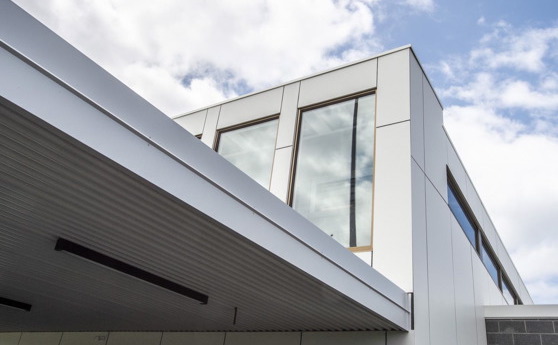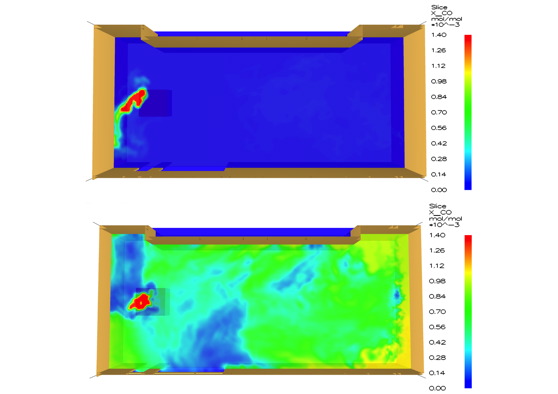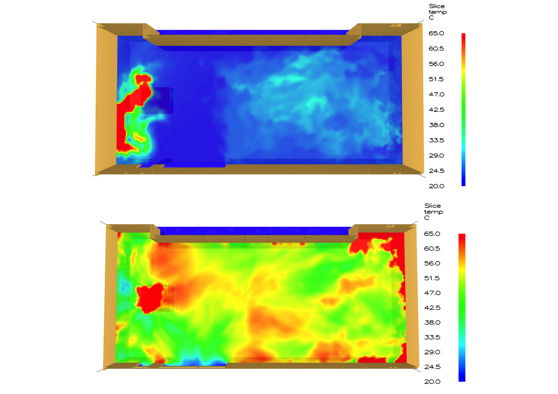
Envelope
Features
HVAC & Plumbing
Can a solar chimney boost fire safety while saving energy? RMIT asks and answers
May 13, 2020 By Anthony Capkun
 The solar chimney at the Mentone Reserve Pavilion. City of Kingston.
The solar chimney at the Mentone Reserve Pavilion. City of Kingston. May 13, 2020 – In a collaboration between RMIT University and the City of Kingston (Australia), researchers designed a solar chimney to maximise its efficiency for both ventilating fresh air and sucking smoke out of a building in case of fire.
Modelling shows the specially-designed solar chimney radically increases the amount of time people have to escape the new building during a fire, extending the safe evacuation time from about 2 minutes to over 14 minutes.
How does a solar chimney work?
A solar chimney is a passive solar heating & cooling system that harnesses natural ventilation to regulate the temperature of a building.
Modern solar chimneys usually feature a wall of glass next to a wall that is painted black, to maximise the absorption of solar radiation. Vents at the top and bottom control the airflow in and out of the chimney for heating or cooling. As the sun warms the chimney, this heats the air inside it.
The hot air rises and is vented out of the top of the chimney, which draws more air in at the bottom, driving ventilation through a building to naturally cool it down. When it’s cold outside, the chimney can be closed, to direct the absorbed heat back into the building and keep it warm.
Mentone Reserve Pavilion project
Dr. Long Shi said solar chimneys have well established environmental credentials, but their potential for improving fire safety had not been explored.

Modelling of carbon monoxide levels about 16 minutes after a fire breaks out shows the dramatic difference in CO with a solar chimney (top) and without (bottom).
Kingston Mayor Georgina Oxley said Council was excited to be a part of the groundbreaking project. “Creating new and innovative ways of reducing energy consumption in our building design is something that is a priority for Council.”
“The solar-chimney that has been installed at the new state-of-the-art Mentone Reserve Pavilion not only allows us to harness clean green energy to heat and cool the building—helping Council achieve its environmental goals—but it also has the potential to save lives in the event of a fire. This is a truly remarkable design.”
While calculations around the 6-fold increase in safe evacuation time were specific to the new building, previous research by the team from RMIT’s School of Engineering has confirmed solar chimneys can successfully achieve both functions: ventilation and smoke exhaustion.
Reducing smoke, increasing safety
During a fire, the same principle—hot air rises—enables the solar chimney to suck smoke out of the building. Less smoke means better visibility, lower temperatures and reduced carbon monoxide, all of which contribute to increasing the amount of time people have to safely evacuate.

The solar chimney helps control temperature in case of a fire. Modelling shows temperature at 16 minutes with a solar chimney (top) and at 3 minutes without a solar chimney (bottom).
To understand exactly how much evacuation time a solar chimney could deliver for a specific building, you need to model for that exact design, Shi said.
“This will differ from building to building, but we know that any extra time is precious and improves fire safety, which could ultimately help to save lives,” he said.
The new research offers a technical guide for optimizing the design and engineering of solar chimneys in real buildings, to expand their application across the two functions.
Print this page